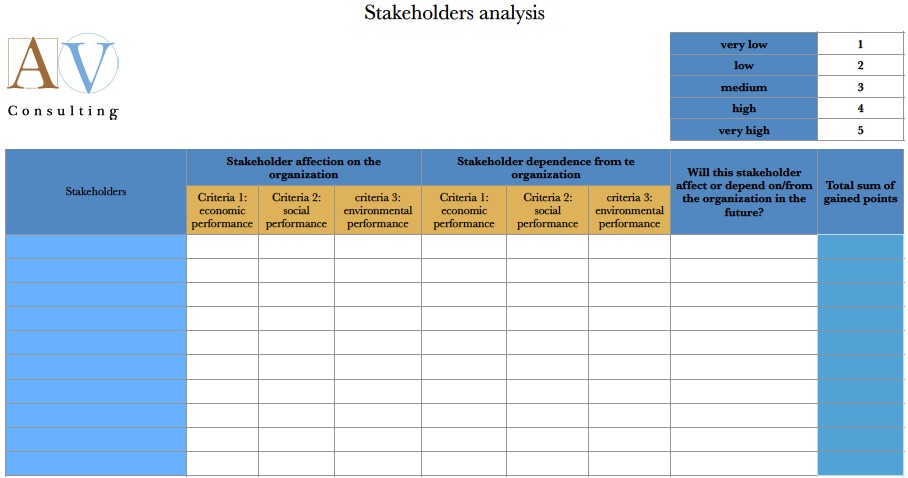This post is also available in: Spanish
In the latest time, I drafted several post regarding the connection between social responsibility, sustainability strategies and safety and health management within organizations. Be they in this blog or in the posts drafted in the site Prevención Integral, I referred to that relation in different ways:
- sustainability reports as global reports on sustainability (article in Spanish), social responsibility and occupational safety and health management;
- the integrated management of sustainability, CSR and OSH as the environment where the next OHS management revolution (article in Spanish) will happen;
- sustainability strategies as the ideal habitat for occupational safety and health.
And some other entries related with the topic.
All these posts feature two key elements which support the respective arguments. One element is actor analysis, and the other is the analysis of material aspects (also called “problem demarcation” in certain posts).
Both tools – actor and material aspects analysis- belong to a overall planning and strategy process of the organization. Both procedures are complement one to each other, they are a part of a sequence.
This is a technical posts on the actor analysis procedure: what it is and how it works.
Definition of “stakeholders” (or “actors”)
Stakeholders are defined as entities or individuals that can reasonably be expected to be significantly affected by the organization’s activities, products, and services; and whose actions can reasonably be expected to affect the ability of the organization to successfully implement its strategies and achieve its objectives. This includes entities or individuals whose rights under law or international conventions provide them with legitimate claims vis-à-vis the organization.
Stakeholders can include those who are invested in the organization (such as employees, shareholders, suppliers) as well as those who have other relationships to the organization (such as vulnerable groups within local communities, civil society).
Stakeholders analysis: identification and prioritization
The procedure to identify and prioritize the stakeholders is called stakeholders (or actor) analysis.
In a simplified way, the stakeholders analysis has two parts:
- stakeholders identification, which, in practice, consist of a detailed list of all the actors -both internal and external- related to the organization throughout the entire value chain. This stage also includes the grouping similar stakeholders according to the features of the organization and the ends that the stakeholders analysis aims.
- stakeholders prioritization. Once the stakeholders are identified and grouped, the next stage is to select and prioritize the key stakeholders of the organization, according to certain aspects, being the most important these three:
- stakeholders affection on the organization;
- stakeholders dependence from the organization;
- stakeholders affection or dependence in the future of the organization.
To develop the stakeholders identification and prioritization, tables like the following are very useful, where each stakeholder is identified and assessed according to the desired criteria and weightings:
In this way, each stakeholder gets a numeric value and a prioritization which may be reviewed by the management board of the organization.
This numeric value and the comments from the management board review, will besides used as input data in the analysis of material aspects, to be treated in further posts.
There are different methods, systems and weighting criteria according to the organization and the objectives aimed with the stakeholders analysis. In this point is where OSH becomes a part of the sustainability and CSR policies of the organizations: the different stakeholders -including the own society- and also renowned standards and states legislation, introduce more and more OSH requirements to the organization´s performance [2].
Whatever the case, what both stakeholders analysis and material aspects analysis require a excellent knowledge of the organization, its sector of activity, its environment, etcetera.
References: [1] GLOBAL REPORTING INITIATIVE. 2013. G4 Sustainability reporting guidelines - Reporting principles and standard disclosures. Página 92. Consultado 24 oct 2014. Bibliografía: [2] ARAGON VALLEY. 11 sept 2014.The position of the occupational safety and health within organizations´ sustainability strategy. http://www.aragonvalley.com/en/occupational-safety-and-health-organizations-sustainability-strategy/. Consulted 1 nov 2014
***
If you liked this blog, you can be informed on new released entries:
- by subscribing to the e-mail notifications;
- following the blog´s Twitter account;
- clicking “like” in the Facebook page;
- adding the blog´s profile to your circles in Google+;
- by subscribing to the feed updates of the blog.


 Aragonese
Aragonese English
English Spanish
Spanish